#New Age of Extinction?
Text

So far we’ve re-experienced a world wide pandemic, the rise of fascism, a titanic disaster and as of this morning, Russian revolution.
It’s like we’re reliving the early 20th century again - only with better plumbing.
62 notes
·
View notes
Text

Artwork elephant, large canvas wall art prints

Unusual gift for boyfriend, girlfriend gift, husband gift, new home gift.

This is a European forest elephant that lived in Europe during the Pleistocene. Along with the forest rhinoceros, "Merka" was one of the main ecosystem engineers in Europe.
#Artwork elephant#large canvas wall art prints#Unusual gift for boyfriend#girlfriend gift#husband gift#new home gift#Used as rustic home decor#living room wall art#kitchen wall decor#college room decor#cottagecore decor#artworks#extinct animal illustration#ice age paleoart#amazing facts#pleistocene#coelodonta antiquitatis#prehistoricfauna#animal wall decor#paleontology#paleoart#sciencegift#science#wildlife#woollyelephant#iceage#iceageart#illustration#dinosaur art#dinopants
35 notes
·
View notes
Text



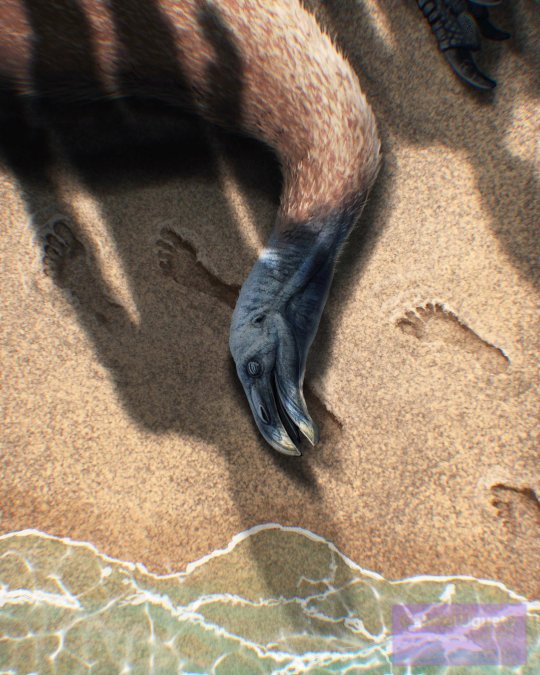

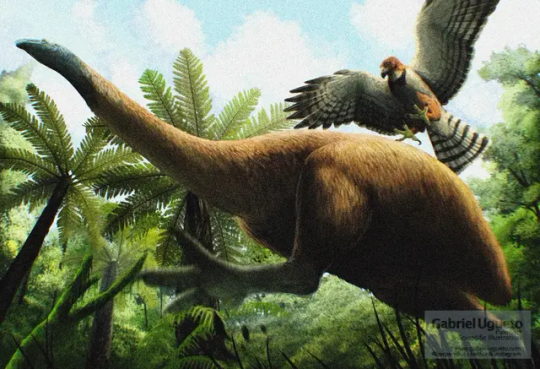
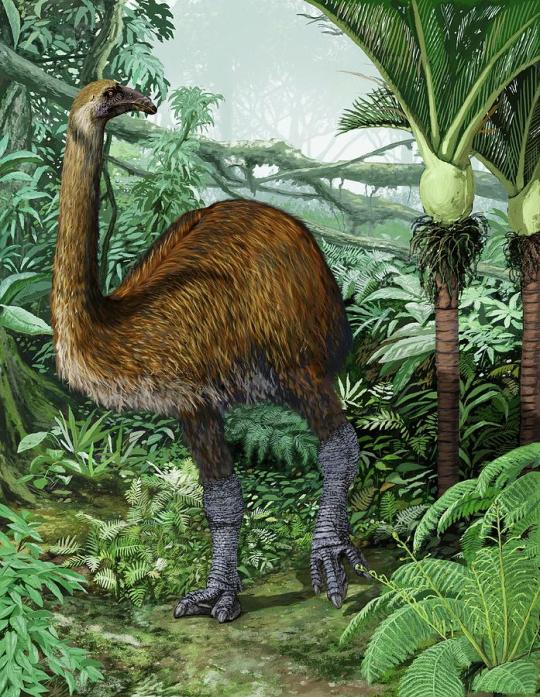
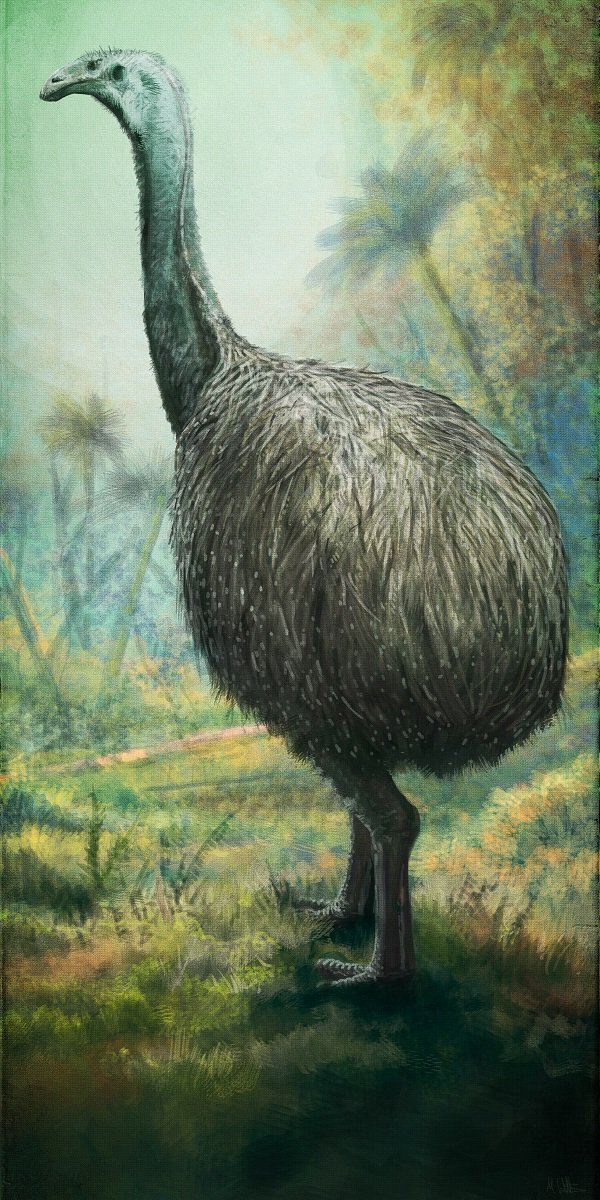
Dinornis better known as the Giant Moa is an extinct genus of birds belonging to the moa family of the suborder order Dinornithiformes, a group of large flightless birds which lived on the islands of New Zealand some 2 million to 500 years ago. There are 2 currently recognized species the North Island giant moa (Dinornis novaezealandiae) and the South Island giant moa (Dinornis robustus). These diurnal avians tended to be found in the lowlands of there island homes inhabiting Shrublands, Grasslands, Coastlands, and Forests where they occupied the niche of large terrestrial browsing herbivore similar to certain antelope, bovines, cervids, and giraffes of today, feeding upon Twigs, seeds, berries, leaves, flowers, fungi, vines, herbs, and shrubs. In life giant moas displayed a large reversed sexual dimorphism whereby the females were up to twice the size of males. With males reaching around 5 to 6.5ft (1.52 to 1.98m) in height and 120 to 195 (55 to 88kg) in weight, and females reaching roughly 10 to 12.5ft (3.05 to 3.81m) in height and 170 to 550lbs (78 to 250kgs) in weight these birds where amongst the largest to ever exist, with the North Island Giant Moa currently holding the record of the tallest bird ever and the South Island Giant Moa being the second tallest. However both are beaten in terms of weight by there fellow recently extinct ratite the elephant bird. Dinornis had long slim, elongated bones compared to other moa species, Maori historical accounts describe the animals as tall, two legged, tailess, wingless giants with slender necks. Brown, slightly streaked, downy, wool like feathers covered all of there bodies sans there heads, feet, and part of the neck. It is believed that the settlement of New Zealand by the Maori directly lead to the Moas extinction, as they were extensively hunted for there meat and feathers. Whats possibly more devastating was the introduction of Polynesian rats and dogs which likely destroyed moa nests and killed moa chicks faster than these large birds could mature and reproduce.The last of the giant moa likely died out around 1500 C.E. with the last species of smaller Moa the Upland Moa possibly holding out until the 1800s.
Art used belongs to the following creators:
Giova Favazzi
Mark Witton
Jaime Chirinos
Gabriel N. U.
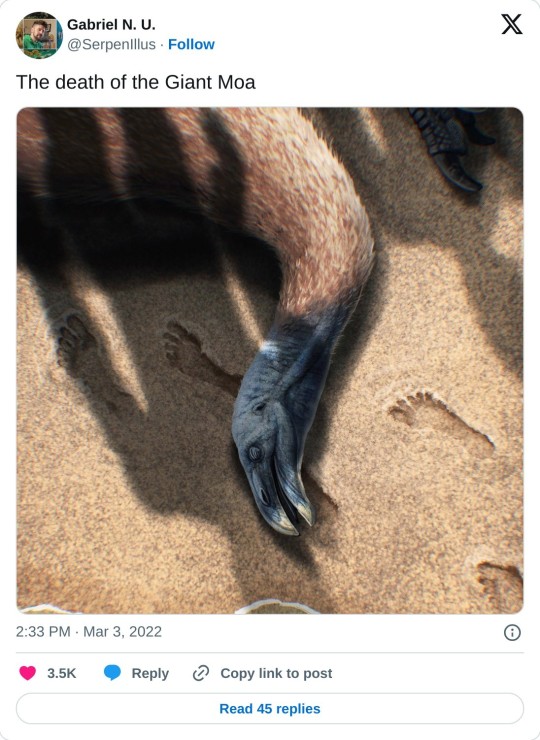
Dana Franklin
#pleistocene pride#pleistocene#pliestocene pride#cenozoic#ice age#stone age#pliestocene#bird#dinosaur#giant moa#moa#new zealand#extinct
8 notes
·
View notes
Text
The Age of Extinction: Flowers ‘Giving Up’ On Scarce Insects And Evolving To Self-Pollinate, Say Scientists
French wild pansies are producing smaller flowers and less nectar than 20 to 30 years ago in ‘startling’ act of evolution, study shows
— Phoebe Weston | Tuesday 19 December 2023 | The Guardian USA

Field pansies (Viola Arvensis) growing near Paris produced 20% less nectar than those growing there 20 to 30 years ago, the study found. Photograph: Courtesy of Samson Acoca-Pidolle
Flowers are “giving up on” pollinators and evolving to be less attractive to them as insect numbers decline, researchers have said.
A study has found the flowers of field pansies growing near Paris are 10% smaller and produce 20% less nectar than flowers growing in the same fields 20 to 30 years ago. They are also less frequently visited by insects.
“Our study shows that pansies are evolving to give up on their pollinators,” said Pierre-Olivier Cheptou, one of the study’s authors and a researcher at the French National Centre for Scientific Research. “They are evolving towards self-pollination, where each plant reproduces with itself, which works in the short term but may well limit their capacity to adapt to future environmental changes.”
Plants produce nectar for insects, and in return insects transport pollen between plants. This mutually beneficial relationship has formed over millions of years of coevolution. But pansies and pollinators may now be stuck in a vicious cycle: plants are producing less nectar and this means there will be less food available to insects, which will in turn accelerate declines.
“Our results show that the ancient interactions linking pansies to their pollinators are disappearing fast,” said lead author Samson Acoca-Pidolle, a doctoral researcher at the University of Montpellier. “We were surprised to find that these plants are evolving so quickly.”
Insect declines have been reported by studies across Europe. One study on German nature reserves found that from 1989 to 2016 the overall weight of insects caught in traps fell by 75%. Acoca-Pidolle added: “Our results show that the effects of pollinator declines are not easily reversible, because plants have already started to change. Conservation measures are therefore urgently needed to halt and reverse pollinator declines.”
The method used in the study is called “resurrection ecology”. It involved germinating ancestral pansy plants from seeds collected in the 1990s and 2000s, which were being stored in the national botanical conservatories. The team compared how four populations of field pansies (Viola arvensis) had changed during this period.
Other than changes to the flowers, they found no other changes between the populations, such as the leaf size or total size of the plant, according to the paper, published in the journal New Phytologist.
If flowers are not likely to attract insects, then a plant is wasting energy making them large and nectar-rich. Previous research has shown the percentage of field pansies relying on self-pollination has increased by 25% over the past 20 years.
Support the GuardianRelated articleHuman-driven extincition of bird species twice as high as thought, study saysRead more
“This is a particularly exciting finding as it shows evolution happening in real time,” said Dr Philip Donkersley, from Lancaster University, who was not involved in the study.
“The fact that these flowers are changing their strategy in response to decreasing pollinator abundance is quite startling. This research shows a plant undoing thousands of years of evolution in response to a phenomenon that has been around for only 50 years.
“Although most research has been done in Europe and North America, we know that pollinator declines are a global phenomenon. These results may just be the tip of the iceberg: areas with far greater plant diversity will likely have many more examples of wild plants changing their pollination strategies in response to a lack of pollinators.”

Foxgloves have evolved to enable pollination by Hummingbirds in Costa Rica, rather than bees, after being introduced to the country 200 years ago. Photograph: Christopher Bellette/Alamy
Similar processes can be seen in invasive populations that need to adapt new ecological niches. Populations of foxglove have evolved to be pollinated by bumblebees in Europe. However, 200 years ago they were introduced to Costa Rica and Colombia, and they have since changed the shape of their flowers so they can be pollinated by hummingbirds, researchers found.
Other research shows plants that are unable to self-pollinate go the other way, producing more pollen when pollinators are scarce. Because they cannot resort to other methods, they have to outcompete other plants to attract a shrinking number of pollinators.
Prof Phil Stevenson, from Royal Botanic Gardens, Kew, who was also not involved in the research, said it made sense that traits that guide or reward pollinators are likely to change when the number of pollinators drops, especially among species that have the option of self-pollinating.
“This is especially so for reproduction,” he said, “which is arguably the most important living function of organisms and likely the most adaptive trait of all.”
#The Age of Extinction | Wild Flowers | Plants | Article#Insects | Environment | Wildlife | Science 🧪 🧬 | Evolution#Biology | Bees | News | Phoebe Weston
0 notes
Text
I KNOW WHY I BUSTED MY ANKLE TODAY. I DIDNT LISTEN TO MY GOOD LUCK BIRTHDAY SONG THIS MORNING
#its reinventing the wheel to run myself over#and when patrick sings ''18 going on extinct'' i sing it with my new age instead#shut up frank
0 notes
Text
lost phineas and ferb episode where perry is called to investigate what dr doofenshmirtz is up to because carl the intern got ahold of some intel that doof has been seen speaking to lawyers and looking up the endangered species act at internet cafes and as major monogram says, "something fishy is going on"
meanwhile phineas and ferb's subplot of "i know what we're gonna do today!" is that isabella needs her environmentalist fireside girls badge so they start researching which species are in urgent need of help in the tri-state area so that they can use new cloning and gene therapy technologies to bring at-risk animals back from extinction
(yes there is a c-plot where buford and baljeet argue the ethics of this idea, i don't have time to explain it all for you rn)
we cut back to🎵doofenshmirtz evil incorporated🎵where we see perry carefully maneuvering around doofenshmirtz's lab scared he might fall into a trap but he hasn't set off a single booby trap and it's clear something is off
he runs into doofenshmirtz and goes to kick him in the gut action movie style but doof steps back one overly confident and says, "nuh uh uh, you see perry the platypus, you are TRAPPED! by the danville section of the endangered species act of 1973!"
doof goes on to explain his tragic backstory: "you see, perry the platypus, when i was a child my parents did not show up for my own birth! but you know that already, yadda yadda yadda they did not love me and then they loved roger more, ANYways i was raised by ocelots! i had a lovely foster mother who took me in and made me one of the pride, and so you see, perry the platypus, i am still legally considered an ocelot. did you know that there are only 50 recorded ocelots still alive in the continental united states? very sad for me as a member of a near-extinct species. it would be immoral for you to hurt someone critically endangered... in fact, you have made many attempts on my life this summer"
[montage of doof's security camera footage of their battles]
"which is why i have decided to bring you... TO COURT!" we cut back to phineas and ferb's back yard where they've decided to start cloning ocelots in their kiddie pool
candace storms outside enraged and says, "phineas and ferb are you cloning ocelots in my duckie momo kiddie pool!?"
ferb's one line of the episode is "well, i guess it's more of a kitty pool, now"
candace storms away saying, "i'm going to tell mom!" and isabella turns to phineas and says, "oh, does your mom have experience in wildlife conservation?"
we cut back to the doof and perry plotline where the two are now in the danville hall of justice and we learn that doof has spent his monthly alimony check on a defense lawyer and perry turns and sees the lawyer and then vanessa helping her organize her briefcase and perry chitters at her and vanessa shrugs and says, "i'm thinking about going into legal defense. sorry perry."
the rest of the doof and perry b-plot is spent in court and perry is about to ask for a public defense lawyer when carl runs into the room and explains that he's owca's official legal defense and perry looks at him like, "uhhh is that even allowed?"
it doesn't matter because apparently the judge is out sick today but because it's danville roger's the judge now because he's the mayor and everyone loves him.
the court case continues.
meanwhile phineas and ferb have successfully cloned multiple ocelots from the original ocelot dna they had on hand and isabella asks phineas if these clones will experience health problems like premature aging, phineas casually explains that ferb figured out the problem while they were experimenting with stem cell harvesting.
back in the courtroom, doof's ocelot foster mother has been brought to the stand along with an ocelot to english translator. doof gets emotional seeing her after so long. she says that he was one of her favorite child and he was as strong a hunter as anyone else in the family. it's incredibly sweet. the jury's in tears.
meanwhile, isabella has established connections with a group in texas who are going to release the ocelots back into their natural habitat and, using the cloned ocelots to prevent inbreeding, help establish an ocelot breeding program. the group explains that they are going to send a helicopter to retrieve the cloned ocelots from danville and bring them to texas soon.
isabella gets her fireside girls badge.
candace manages to get mom to see the backyard only after the ocelots have been helicoptered off to coastal texas, their primary habitat.
mom makes it into the backyard as phineas stares wistfully over the fence and says, "if you love something, you have to let it go." candace goes, "look mom look look look!" and points at the ducky momo kiddie pool, devoid of cloned ocelots, where baljeet and buford are now chilling out, having settled their philosophical debate about the ethics of animal cloning.
back in the courtroom drama, doof looks like he's about to win when an attendant walks into the courtroom and whispers something in roger's ear.
roger looks up, grinning, and says, "good news, everyone! my attendant here has just enlightened me that ocelots are no longer considered critically endangered!"
this settles the case, with perry being decreed not guilty and the entire affair being called off. the courtroom cheers, roger walks over to doof and personally congratulates him on his species' return from the brink of extinction.
doof shouts, "curse you endangered species classification system!" at the ceiling of the danville hall of justice.
perry arrives back home just in time for mom to say, "who wants pie?"
the end.
#cricket.chatterbox#phineas and ferb#pnf#dr doofenshmirtz#perry the platypus#phineas flynn#ferb fletcher#greatest hits
41K notes
·
View notes
Text
Earth's Icy Past: Understanding the History of Ice Ages | Proterozoic Snowball Earth
Understanding the History of Ice Ages
Earth’s Ice Ages are periods in the planet’s history characterized by a significant drop in global temperatures, leading to the expansion of ice sheets and glaciers. These periods can last for thousands or even millions of years, and have occurred periodically throughout the planet’s history. The study of Earth’s Ice Ages provides valuable insights into the causes and consequences of climate…

View On WordPress
#Analyzing Ice Cores#Causes of Ice Ages#Climate Change#Earth&039;s Ecosystems#First Ice Age#Geological Formations#Greenhouse#Human Adaptation#Ice Ages#Mitigating the Effects of Climate#Natural Phenomenon#New Technologies#Proterozoic Snowball Earth#Sediment Record#Species Extinction#Survival Strategies#Understanding the History#Well-Known Ice Age
0 notes
Text
The Best News of Last Week
1. A branch of the flu family tree has died and won't be included in future US vaccines

A type of flu virus that used to sicken people every year hasn't been spotted anywhere on Earth since March 2020. As such, experts have advised that the apparently extinct viruses be removed from next year's flu vaccines.
The now-extinct viruses were a branch of the influenza B family tree known as the Yamagata lineage. Scientists first reported the apparent disappearance of Yamagata viruses in 2021.
2. Hospitals must obtain written consent for pelvic and similar exams, the federal government says

Hospitals must obtain written informed consent from patients before subjecting them to pelvic exams and exams of other sensitive areas — especially if an exam will be done while the patient is unconscious, the federal government said Monday.
New guidance from the U.S. Department of Health and Human Services now requires consent for breast, pelvic, prostate and rectal exams for “educational and training purposes” performed by medical students, nurse practitioners or physician assistants.
3. Germany approves new law that will allow adults to carry up to 25 grams of cannabis for their own consumption and store up to 50 grams at home.

Germany's upper house, the Bundesrat, cleared the way to partially legalize cannabis on Friday. Adults aged 18 and over will be allowed to carry up to 25 grams of cannabis for their own consumption.
4. Tick-killing pill shows promising results in human trial | Should it pan out, the pill would be a new weapon against Lyme disease.

Tarsus Pharmaceuticals is developing a pill for humans that could provide protection against the tick-borne disease for several weeks at a time. In February, the Irvine, California–based biotech company announced results from a small, early-stage trial showing that 24 hours after taking the drug, it can kill ticks on people, with the effects lasting for up to 30 days.
5. Thailand moves to legalise same-sex marriage

Thailand has taken a historic step closer to marriage equality after the lower house passed a bill giving legal recognition to same-sex marriage.
It still needs approval from the Senate and royal endorsement to become law but it is widely expected to happen by the end of 2024, making Thailand the only South East Asian country to recognise same-sex unions.
6. French Revolution: Cyclists Now Outnumber Motorists In Paris

Official measurements have found that Paris is rapidly becoming a city of transportation cyclists. In the suburbs, where public transit is less dense, transport by car was found to be the main form of mobility. But for journeys from the outskirts of Paris to the center, the number of cyclists now far exceeds the number of motorists, a huge change from just five years ago.
7. 'Miracle' operation reverses blindness in three-year-old girl giving her 'promising' future

A three year old with a genetic condition that causes blindness is doing incredibly well after unique pioneering operation to restore her sight.
The UK is the only country performing keyhole eye surgery to inject healthy copies of a gene into sufferers’ eyes. It is being used to reverse blindness in children born with a rare condition which means they can only distinguish between light and dark. And it has given little Khadijah Chaudhry, born with Leber congenital amaurosis-4, a chance at seeing properly again.
---
That's it for this week :)
This newsletter will always be free. If you liked this post you can support me with a small kofi donation here:
Buy me a coffee ❤️
Also don’t forget to reblog this post with your friends.
825 notes
·
View notes
Text
TOP TEN DINOSAURUSES
maybe you're wondering my most tenned favorite dinosauruses??? The science study of dinasacacers is called "dinosaurusology" by leading experts like myself, and it is constantly changing as we make new uncoveries almost every tuesday when we find new bones in my cousin rob's garage (he hasn't thrown anything out since the 90's!) As such bear in mind that up to two facts I am about to share could become dated over the course of the next century, however as both the king and queen of science this will only be true if I'm still available to approve the new facts. If I'm dead or kind of tired then nobody will ever know what's true anymore so you should be nice to me.
#10: OVIRAPTOR

OVIRAPTOR was a good model for what all dinosacans were like: it was a wrinkly lizard that slithered in filthy dirt and had difficulty standing upright because its bones were made of rocks. This is why we have the term "the stone age," so be grateful you're living in "the bone age!" Oviraptor's name means "eggs velociraptor" because it was a kind of velociraptor that stole eggs. It didn't know what to do with them because nobody invented cooking yet and raw dinosaur eggs were disgusting, so every oviraptor starved to death.
#9: IGUANADON

This was the last known photograph of IGUANA DON (not to be confused with his cousin iguana dan) when george washington invented photographs 2 million years ago. Don was an ugly disgusting hilarious lizard monster with one horn on its nose and he died because he evolved a dining room in his torso exactly the right size for 21 cavemen to walk in and eat his kidneys. This was not helped by don's instinct to sleep on a big porch under a chandelier.
#9 DIMETRODON

DIMETRODON was the most common dinosaur of jurassic, which was the fifth and final era of dinosaurs after the ice age but before the ediacaran. In fact dimetrodon was the very last dinosaur to ever exist on earth before they were all eaten to death by the ediacaran's dominant predator: a species of swirly looking weird rock. Nobody knows why these swirly looking weird rocks died out, but it's most likely because dimetrodon was so poisonous from its diet of entirely pufferfish. You can tell it was a sea dinosaur because of its fish fin!
#8: PTERADACTYL
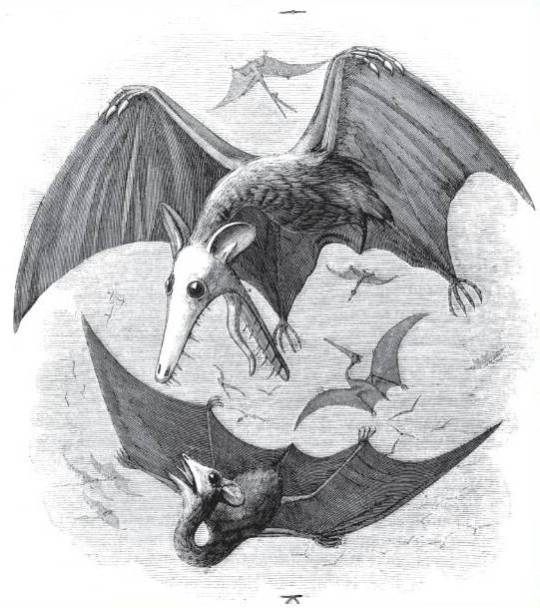
PTERODACTYL was a regular dinosaur until it got married to a species of bat and its bat wife laid a bunch of pterodactyl eggs! This woodcut is however inaccurate: flying would not be invented until president obama discovered the first airplane in 1998, so pterodactyl couldn't possibly have stayed in the air and just immediately fell. The long 900 million year reign of the pterodactyl abruptly ended when the last one finally hit the ground (it took longer in those days because the oxygen disaster made so much more air)
#7 SNORKASAURUS
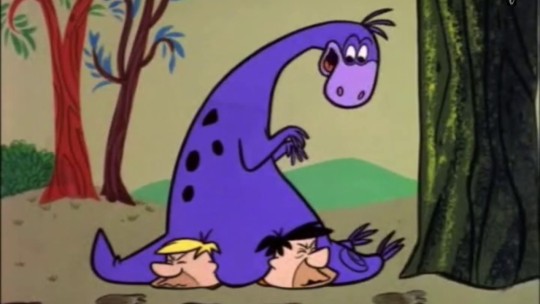
SNORKASAURUS was completely unique among all dinocaurs by having a really long neck. It was one of the largest creatures to ever roam the earth at over 7 feet tall, or exactly 12 meters to those of you living in Liberia or Myanmar! This is the last known photograph of snorkasaurus, giving birth to the first cavemen. Snorkasaurus went extinct because all of them did this instead of making baby snorkasauruses. This is because like all dinosaurii they had only a tiny peanut for a brain, and nobody was around to give them 'the talk' because that wasn't invented yet.
#6 SMILODON

SMILODON was a very special dinosaurn because it was the first one to stand up on its hind legs after years of rigorous exercise and weight training. By inventing this new way of walking, Smilodon made it possible for the first monkeys to evolve! This is called "convergent" evolution.
#5 BULBASAUR

BULBASAUR was a majestic and beautiful species of neopet unfortunately disliked by the scientific community because it is the reason there are no flying dinosuars. Bulbasaur was the first ever flying dyanasar ever invented, 19 billion years ago on September 10, 2001, but the project was discontinued when its first test flight ended in a tragic accident. That's right: on September 11, 2001, Bulbasaur crashed into the stock market, causing the great depression that lead to the civil war :'( now to this very day, flying dinosarers are against the law.
#4 YOSHI

YOSHI is a type of dinersaulophus called a "bird," which was actually the second attempt by early neanderthal alchemists to manufacture a street legal flying dinnersauran, but the New Zealand government realized if dinophlofbuses can fly, then bats would no longer be special, and since bats are New Zealand's only major export it would have been an economic disaster. The queen of Australia (New Zealand's largest city) ordered the CIA to sand all of the wings off of these early prototype birds. Every bird tragically went extinct when it looked down, noticed how high up it was and remembered it could not fly, activating the effects of Earth's gravitational field.
#3 ANOMALOCARIS

ANOMALOCARIS was the dinosorcerous that discovered the first primitive cave painting of a modern day crab and invented carcinisation. All the other dinanders laughed at Anomalocaris for wanting to turn into a crab, but guess what??? Every single kind of dinosaur is dead but there's a crab still alive at 29, making it the oldest person in the world. Who's FUCKING laughing now!!!!!!!!!!!!!!!!!!
#2 EARL SINCLAIR

This is the last known photograph of Earl Sinclair, seen here as an uncredited extra in "Avatar 3: Lost in New York." Earl Sinclair was a sindonaur species that could disguise itself as a human by putting on sunglasses, a necessary adaptation in order to hide from the largest predator dancasore to ever live: Mellisuga helenae. However, near the end of the coal age, M. Helenae finally remembered that sunglasses hadn't even been invented yet. Look carefully, and you'll notice nobody is wearing sunglasses at all in this scene, making Earl Sinclair stick out like a sore thumb! If you're still having difficulty, here's a zoomed in image of this majestic thunder lizard:

Unfortunately......this wardrobe malfunction made Mr. Sinclair just as obvious to his ancient enemy, and the last Earl Sinclair's brains were sucked out on September 11, 2001, the darkest day in British history because he was the only one who knew the recipe to chicken mcnuggets (the only british food.) To this day all british people are extinct but you can still see their fossilized skeletons waiting in line at the department of motor vehicles.
#1 CONCAVENATOR

Concavenator was an Early Cretaceous carcharodontosaurid up to six meters in length with an unusual pointed crest on its back.
#science#dinosaurs#paleobiology#paleoart#nature#animals#lizards#reptiles#birds#ADAD don't get mad at me I actually hope if you ever see this you just find it cute and enjoy the convoluted references I put in
3K notes
·
View notes
Text
I got a Geiger counter!
Let’s look through my collection for some Spicy Rocks! I’ve never deliberately collected radioactive specimens, so I have no idea what I’m going to find.
First, though, let’s test the baseline level of radiation in my house.

It’s fun to hear the Geiger counter click as it detects radiation. 20 counts per minute. Nice! You’re unlikely to ever see a count of zero, as pretty much everything in the world, including the human body, gives off a little bit of radiation.
20 is a normal baseline, nothing to be concerned about. Standing in my house, I’m getting a radiation dose of about 0.00013 milliseieverts per hour - or a little over one mSv a year. This is an average yearly dosage of radiation for people in my country, and is something my body can easily process. For context, a dosage of 100 mSv would slightly increase my risk of cancer, and a dosage of 1000 mSv would immediately give me radiation sickness.
But enough about these boring, safe amounts of radiation. I want to see some spice! Let’s check over by the Rock Wall!

Hm, I’d expected the CPM to be noticeably higher around my rock collection, but I’m getting nothing! Even testing each individual rock, nothing’s more than a few ticks above the baseline. So far, my fancy new toy is looking like wasted money. :c

WAIT! THERE!! 62 CPM! That’s three times higher than the base reading in the rest of my house!!! YESSS!! THIS ROCK IS SPICY!!!!


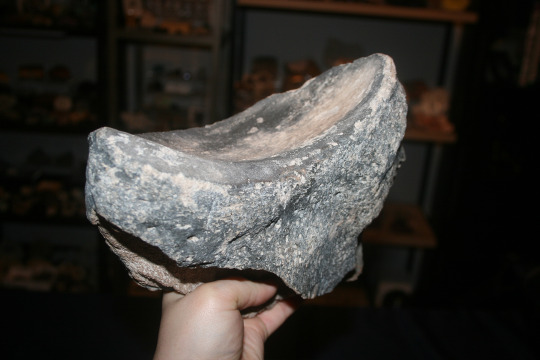
Here’s the rock that’s setting off my Geiger counter. (Yes I’m touching the spicy rock with my bare hands, don’t worry about it.)
This fossil, which is as big as my head, is part of the femur bone of a Megalonyx, a North American giant ground sloth!

These huge animals could grow as big as ten feet tall. They lived alongside humans during the last ice age, and it’s theorized that humans may have hunted them to extinction. This particular fossil was found in a phosphate mine!
Why is it radioactive? Because... sometimes fossils are just radioactive! They spend a lot of time in the ground, which is full of radioactive minerals, and often radiation just gets all up in there. There are some fossils on display in museums which are so radioactive that they have to be coated with lead paint for the safety of curators and museum-goers! Compared to those, this femur bone is barely radioactive at all.
So is it really safe for me to have this in my house, much less handle it with my bare hands? Well, yeah! Remember, despite having this spicy rock in my collection, the radiation baseline in my house is completely normal. Here’s why.

Even just a few centimeters away from this specimen, the Geiger counter’s reading is halved. A few inches away, and it can’t detect any radiation at all. It basically has to be directly touching the rock to get an abnormal reading. Which means I also have to be touching the rock to receive a meaningful amount of radiation exposure.
But even holding this rock in my hands, I’m only getting a dosage of about 0.0004 mSv per hour. If I never let go of this rock for an entire year, I would get a dose of about 3.5 mSv. Which is... still completely within the safe threshold for my body to process. Nothing to worry about!
Man, I gotta start collecting some spicier rocks.
#rock collecting#red pen has cool rocks#fossils#north american giant ground sloth#geiger counter#radiation
4K notes
·
View notes
Text
sometimes i think about the span of human existence and how if you spread your arms out in a long line and said my body is acting as a poem of all the universe's birthdays, the smallest sliver of your furthest nail would be our entire history as humans. and you, doing this, feeling your sternum crack into place because you're-getting-old and all of your bones crunch these days: you are the universe, measuring its own timeline. you're the memory of a starburst saying i gave birth to humans at the tip of my finger.
and i think about how crocodiles have been around for way longer than that fingernail and how sharks have been here forever too and how there are sea cucumbers that understand time like an angel would; their ages so astronomically long that i get dizzy looking down into them. i think about my dog, and how i am so fantastically ancient to him (an impossible number, staggering) and how, at the same time, i can order my life in eras of pets-i-have-loved and how my childhood died when my cat did.
and i wonder if the earth does the same thing, if nature keeps time in epochs. if the tree in the house where i grew up said oh a new family and got upset when one by one we all left for college and left behind our climbing and screaming and birdhouses. that same tree collapsed during a bad storm this winter; heartbroken. the whole inside was a hull, shivering and empty. it missed our roof by a whisper, almost like it held itself together so it couldn't pass a hole into the house it's been looking into for years now. the people who took it away clicked their teeth. it was a hundred years old, at least.
there are things that went extinct in my lifetime. there are memories that don't extend to the tip of the finger. four years ago, for the first time: i saw a bald eagle in the wild. ever since they've been sprouting strangely in my life, their origami frames hunched in a racket of brown feathers. something in the motion of wild animals braced against the new england weather - like we all (all of nature, all of the fingertip) have the same shared hate when it's cold sorrow. like in years and years and years of history we never really evolved a better method than to close your eyes and brace yourself against it.
i saw a butterfly today, staggering drunkenly in the early spring air. it's too early for her other friends. i want to tuck her back into bed and say it's not your time yet! her life like a pinprick in my own. in butterfly school they'd have to stretch out their scales and say - at the end of your furthest wing is where you are in the life of a human. she is in my life, isn't she. something about how my heart seized at the sight of her, so brave and lonely and unfair; and how it snowed yesterday (and will snow again, probably), and how, in spite of that, she was out there and flying.
something about waking up this morning and thinking - i'm too old for this. how my hips and knees and back all make new noises. how the other day at a grocery store i picked up the gloves an older woman had dropped, how she'd laughed and thanked me - i can't bend down like you young folks anymore.
something about the theory that there's been no visible life on other planets because we are too early. that we are the first butterfly of spring. all this bravery. we know it is probably hopeless, and still we go. breathless, the same tactic - we brace against the cold.
4K notes
·
View notes
Text

Artwork elephant - Forest European elephant - Palaeoloxodon antiquus

This is a European forest elephant that lived in Europe during the Pleistocene. Along with the forest rhinoceros, "Merka" was one of the main ecosystem engineers in Europe.



This exclusive and unrepeatable painting can be purchased here:
https://www.etsy.com/KapelkaStudio/listing/1498323241
#Artwork elephant#large canvas wall art prints. Unusual gift for boyfriend#girlfriend gift#husband gift#new home gift. Used as rustic home decor#living room wall art#kitchen wall decor#college room decor#cottagecore decor#paleoart#prehistoricfauna#animal wall decor#extinct animal illustration#ice age paleoart#paleontology#prehistoricartwork#pleistocene#elephant#amazing facts
9 notes
·
View notes
Text
Apple to EU: “Go fuck yourself”

If you'd like an essay-formatted version of this post to read or share, here's a link to it on pluralistic.net, my surveillance-free, ad-free, tracker-free blog:
https://pluralistic.net/2024/02/06/spoil-the-bunch/#dma

There's a strain of anti-anti-monopolist that insists that they're not pro-monopoly – they're just realists who understand that global gigacorporations are too big to fail, too big to jail, and that governments can't hope to rein them in. Trying to regulate a tech giant, they say, is like trying to regulate the weather.
This ploy is cousins with Jay Rosen's idea of "savvying," defined as: "dismissing valid questions with the insider's, 'and this surprises you?'"
https://twitter.com/jayrosen_nyu/status/344825874362810369?lang=en
In both cases, an apologist for corruption masquerades as a pragmatist who understands the ways of the world, unlike you, a pathetic dreamer who foolishly hopes for a better world. In both cases, the apologist provides cover for corruption, painting it as an inevitability, not a choice. "Don't hate the player. Hate the game."
The reason this foolish nonsense flies is that we are living in an age of rampant corruption and utter impunity. Companies really do get away with both literal and figurative murder. Governments really do ignore horrible crimes by the rich and powerful, and fumble what rare, few enforcement efforts they assay.
Take the GDPR, Europe's landmark privacy law. The GDPR establishes strict limitations of data-collection and processing, and provides for brutal penalties for companies that violate its rules. The immediate impact of the GDPR was a mass-extinction event for Europe's data-brokerages and surveillance advertising companies, all of which were in obvious violation of the GDPR's rules.
But there was a curious pattern to GDPR enforcement: while smaller, EU-based companies were swiftly shuttered by its provisions, the US-based giants that conduct the most brazen, wide-ranging, illegal surveillance escaped unscathed for years and years, continuing to spy on Europeans.
One (erroneous) way to look at this is as a "compliance moat" story. In that story, GDPR requires a bunch of expensive systems that only gigantic companies like Facebook and Google can afford. These compliance costs are a "capital moat" – a way to exclude smaller companies from functioning in the market. Thus, the GDPR acted as an anticompetitive wrecking ball, clearing the field for the largest companies, who get to operate without having to contend with smaller companies nipping at their heels:
https://www.techdirt.com/2019/06/27/another-report-shows-gdpr-benefited-google-facebook-hurt-everyone-else/
This is wrong.
Oh, compliance moats are definitely real – think of the calls for AI companies to license their training data. AI companies can easily do this – they'll just buy training data from giant media companies – the very same companies that hope to use models to replace creative workers with algorithms. Create a new copyright over training data won't eliminate AI – it'll just confine AI to the largest, best capitalized companies, who will gladly provide tools to corporations hoping to fire their workforces:
https://pluralistic.net/2023/02/09/ai-monkeys-paw/#bullied-schoolkids
But just because some regulations can be compliance moats, that doesn't mean that all regulations are compliance moats. And just because some regulations are vigorously applied to small companies while leaving larger firms unscathed, it doesn't follow that the regulation in question is a compliance moat.
A harder look at what happened with the GDPR reveals a completely different dynamic at work. The reason the GDPR vaporized small surveillance companies and left the big companies untouched had nothing to do with compliance costs. The Big Tech companies don't comply with the GDPR – they just get away with violating the GDPR.
How do they get away with it? They fly Irish flags of convenience. Decades ago, Ireland started dabbling with offering tax-havens to the wealthy and mobile – they invented the duty-free store:
https://en.wikipedia.org/wiki/Duty-free_shop#1947%E2%80%931990:_duty_free_establishment
Capturing pennies from the wealthy by helping them avoid fortunes they owed in taxes elsewhere was terribly seductive. In the years that followed, Ireland began aggressively courting the wealthy on an industrial scale, offering corporations the chance to duck their obligations to their host countries by flying an Irish flag of convenience.
There are other countries who've tried this gambit – the "treasure islands" of the Caribbean, the English channel, and elsewhere – but Ireland is part of the EU. In the global competition to help the rich to get richer, Ireland had a killer advantage: access to the EU, the common market, and 500m affluent potential customers. The Caymans can hide your money for you, and there's a few super-luxe stores and art-galleries in George Town where you can spend it, but it's no Champs Elysees or Ku-Damm.
But when you're competing with other countries for the pennies of trillion-dollar tax-dodgers, any wins can be turned into a loss in an instant. After all, any corporation that is footloose enough to establish a Potemkin Headquarters in Dublin and fly the trídhathach can easily up sticks and open another Big Store HQ in some other haven that offers it a sweeter deal.
This has created a global race to the bottom among tax-havens to also serve as regulatory havens – and there's a made-in-the-EU version that sees Ireland, Malta, Cyprus and sometimes the Netherlands competing to see who can offer the most impunity for the worst crimes to the most awful corporations in the world.
And that's why Google and Facebook haven't been extinguished by the GDPR while their rivals were. It's not compliance moats – it's impunity. Once a corporation attains a certain scale, it has the excess capital to spend on phony relocations that let it hop from jurisdiction to jurisdiction, chasing the loosest slots on the strip. Ireland is a made town, where the cops are all on the take, and two thirds of the data commissioner's rulings are eventually overturned by the federal court:
https://www.iccl.ie/digital-data/iccl-2023-gdpr-report/
This is a problem among many federations, not just the EU. The US has its onshore-offshore tax- and regulation-havens (Delaware, South Dakota, Texas, etc), and so does Canada (Alberta), and some Swiss cantons are, frankly, batshit:
https://lenews.ch/2017/11/25/swiss-fact-some-swiss-women-had-to-wait-until-1991-to-vote/
None of this is to condemn federations outright. Federations are (potentially) good! But federalism has a vulnerability: the autonomy of the federated states means that they can be played against each other by national or transnational entities, like corporations. This doesn't mean that it's impossible to regulate powerful entities within a federation – but it means that federal regulation needs to account for the risk of jurisdiction-shopping.
Enter the Digital Markets Act, a new Big Tech specific law that, among other things, bans monopoly app stores and payment processing, through which companies like Apple and Google have levied a 30% tax on the entire app market, while arrogating to themselves the right to decide which software their customers may run on their own devices:
https://pluralistic.net/2023/06/07/curatorial-vig/#app-tax
Apple has responded to this regulation with a gesture of contempt so naked and broad that it beggars belief. As Proton describes, Apple's DMA plan is the very definition of malicious compliance:
https://proton.me/blog/apple-dma-compliance-plan-trap
Recall that the DMA is intended to curtail monopoly software distribution through app stores and mobile platforms' insistence on using their payment processors, whose fees are sky-high. The law is intended to extinguish developer agreements that ban software creators from informing customers that they can get a better deal by initiating payments elsewhere, or by getting a service through the web instead of via an app.
In response, Apple, has instituted a junk fee it calls the "Core Technology Fee": EUR0.50/install for every installation over 1m. As Proton writes, as apps grow more popular, using third-party payment systems will grow less attractive. Apple has offered discounts on its eye-watering payment processing fees to a mere 20% for the first payment and 13% for renewals. Compare this with the normal – and far, far too high – payment processing fees the rest of the industry charges, which run 2-5%. On top of all this, Apple has lied about these new discounted rates, hiding a 3% "processing" fee in its headline figures.
As Proton explains, paying 17% fees and EUR0.50 for each subscriber's renewal makes most software businesses into money-losers. The only way to keep them afloat is to use Apple's old, default payment system. That choice is made more attractive by Apple's inclusion of a "scare screen" that warns you that demons will rend your soul for all eternity if you try to use an alternative payment scheme.
Apple defends this scare screen by saying that it will protect users from the intrinsic unreliability of third-party processors, but as Proton points out, there are plenty of giant corporations who get to use their own payment processors with their iOS apps, because Apple decided they were too big to fuck with. Somehow, Apple can let its customers spend money Uber, McDonald's, Airbnb, Doordash and Amazon without terrorizing them about existential security risks – but not mom-and-pop software vendors or publishers who don't want to hand 30% of their income over to a three-trillion-dollar company.
Apple has also reserved the right to cancel any alternative app store and nuke it from Apple customers' devices without warning, reason or liability. Those app stores also have to post a one-million euro line of credit in order to be considered for iOS. Given these terms, it's obvious that no one is going to offer a third-party app store for iOS and if they did, no one would list their apps in it.
The fuckery goes on and on. If an app developer opts into third-party payments, they can't use Apple's payment processing too – so any users who are scared off by the scare screen have no way to pay the app's creators. And once an app creator opts into third party payments, they can never go back – the decision is permanent.
Apple also reserves the right to change all of these policies later, for the worse ("I am altering the deal. Pray I don't alter it further" -D. Vader). They have warned developers that they might change the API for reporting external sales and revoke developers' right to use alternative app stores at its discretion, with no penalties if that screws the developer.
Apple's contempt extends beyond app marketplaces. The DMA also obliges Apple to open its platform to third party browsers and browser engines. Every browser on iOS is actually just Safari wrapped in a cosmetic skin, because Apple bans third-party browser-engines:
https://pluralistic.net/2022/12/13/kitbashed/#app-store-tax
But, as Mozilla puts it, Apple's plan for this is "as painful as possible":
https://www.theverge.com/2024/1/26/24052067/mozilla-apple-ios-browser-rules-firefox
For one thing, Apple will only allow European customers to run alternative browser engines. That means that Firefox will have to "build and maintain two separate browser implementations — a burden Apple themselves will not have to bear."
(One wonders how Apple will treat Americans living in the EU, whose Apple accounts still have US billing addresses – these people will still be entitled to the browser choice that Apple is grudgingly extending to Europeans.)
All of this sends a strong signal that Apple is planning to run the same playbook with the DMA that Google and Facebook used on the GDPR: ignore the law, use lawyerly bullshit to chaff regulators, and hope that European federalism has sufficiently deep cracks that it can hide in them when the enforcers come to call.
But Apple is about to get a nasty shock. For one thing, the DMA allows wronged parties to start their search for justice in the European federal court system – bypassing the Irish regulators and courts. For another, there is a global movement to check corporate power, and because the tech companies do the same kinds of fuckery in every territory, regulators are able to collaborate across borders to take them down.
Take Apple's app store monopoly. The best reference on this is the report published by the UK Competition and Markets Authority's Digital Markets Unit:
https://assets.publishing.service.gov.uk/media/63f61bc0d3bf7f62e8c34a02/Mobile_Ecosystems_Final_Report_amended_2.pdf
The devastating case that the DMU report was key to crafting the DMA – but it also inspired a US law aimed at forcing app markets open:
https://www.congress.gov/bill/117th-congress/senate-bill/2710
And a Japanese enforcement action:
https://asia.nikkei.com/Business/Technology/Japan-to-crack-down-on-Apple-and-Google-app-store-monopolies
And action in South Korea:
https://www.reuters.com/technology/skorea-considers-505-mln-fine-against-google-apple-over-app-market-practices-2023-10-06/
These enforcers gather for annual meetings – I spoke at one in London, convened by the Competition and Markets Authority – where they compare notes, form coalitions, and plan strategy:
https://www.eventbrite.co.uk/e/cma-data-technology-and-analytics-conference-2022-registration-308678625077
This is where the savvying breaks down. Yes, Apple is big enough to run circles around Japan, or South Korea, or the UK. But when those countries join forces with the EU, the USA and other countries that are fed up to the eyeballs with Apple's bullshit, the company is in serious danger.
It's true that Apple has convinced a bunch of its customers that buying a phone from a multi-trillion-dollar corporation makes you a member of an oppressed religious minority:
https://pluralistic.net/2024/01/12/youre-holding-it-wrong/#if-dishwashers-were-iphones
Some of those self-avowed members of the "Cult of Mac" are willing to take the company's pronouncements at face value and will dutifully repeat Apple's claims to be "protecting" its customers. But even that credulity has its breaking point – Apple can only poison the well so many times before people stop drinking from it. Remember when the company announced a miraculous reversal to its war on right to repair, later revealed to be a bald-faced lie?
https://pluralistic.net/2023/09/22/vin-locking/#thought-differently
Or when Apple claimed to be protecting phone users' privacy, which was also a lie?
https://pluralistic.net/2022/11/14/luxury-surveillance/#liar-liar
The savvy will see Apple lying (again) and say, "this surprises you?" No, it doesn't surprise me, but it pisses me off – and I'm not the only one, and Apple's insulting lies are getting less effective by the day.

Image:
Alex Popovkin, Bahia, Brazil from Brazil (modified)
https://commons.wikimedia.org/wiki/File:Annelid_worm,_Atlantic_forest,_northern_littoral_of_Bahia,_Brazil_%2816107326533%29.jpg
CC BY 2.0
https://creativecommons.org/licenses/by/2.0/deed.en
--
Hubertl (modified)
https://commons.wikimedia.org/wiki/File:2015-03-04_Elstar_%28apple%29_starting_putrefying_IMG_9761_bis_9772.jpg
CC BY-SA 4.0
https://creativecommons.org/licenses/by-sa/4.0/deed.en
#pluralistic#apple#malicious compliance#dma#digital markets act#eu#european union#federalism#corporatism#monopolies#trustbusting#regulation#protonmail#junk fees#cult of mac#interoperability#browser wars#firefox#mozilla#webkit#browser engines
594 notes
·
View notes
Text
Strap in for the Soresu form III Obi-Wan lightsaber post. This is gonna be a sad one, girlies. We’re getting into Obi-Wan’s Fucking Trauma.
Qui-Gon’s death changed literally everything about Obi-Wan’s life, right down to the lightsaber form. Still a Padawan himself, he had to watch as an extinct monster from his nightmares* utterly took apart the form he’d learned since he was a child, and then, to complete the destruction, slaughtered the teacher who’d taught him the form and raised him. The devastation of Qui-Gon’s actual death had to be the last in a cascading series of horrors that started with the gut-sinking realization that Qui-Gon was losing. And if all of that weren’t enough, Obi-Wan also loses his own lightsaber in the same duel, a psychological blow to his personhood which we don’t have to guess at the significance of. Obi-Wan tells us the cost of it himself in AotC: this weapon is your life.
The Duel of the Fates on a sheer physical level is a devastating thing to consider. It’s a grueling, full out running battle, the likes of which we don’t see elsewhere in the saga. The beauty (and pounding musical score) of the fight distracts from the sheer brutality of it. Maul is physically attacking them at every turn; he manages to kick Qui-Gon hard enough to knock all 6’3 of him off his feet; he dumps Obi-Wan into a fall that seems to be several stories high. We don’t see Obi-Wan get back up off the floor with Qui-Gon’s body at the end of the duel, and I’d be surprised if he was physically able to even stand again so after the adrenaline faded and the soreness and exhaustion took over. He just been whirled in a lightsaber blender.
I can’t imagine how hard it was for him to pick up a lightsaber again after the trauma of that battle - much less, a new, unfamiliar one, not the kyber crystal that had been his since he was a child. The new canon’s emphasis on the spiritual relationship between a Jedi and their crystal makes this detail even more excruciating. The Ataru form itself must have felt broken and unusable. How can you put your trust in a form once you watched it be broken so ruthlessly?
And this is where Obi-Wan is so endlessly beautiful as a character. He goes through this horrifying experience of violent unmaking, and instead of avoiding lightsabers as an understandable trauma response, or picking up an overwhelming power and dominance form like V, he remakes himself into a master of Soresu: a form of simple, complete defense. He doesn’t attempt to become a weapon of attack like Maul did to disintegrate Ataru; he makes himself invincible, untouchable, with a perfect defense. Soresu works the pieces that fell apart for the Jedi in the Duel of the Fates to an advantage. It is a form of ultimate endurance, of playing out your opponent and staying up in a fight until the attacker is exhausted or angry. It preserves and it lasts. It is philosophical. It is considered. It lacks the showy flash of Makashi or Ataru and returns to the basics, even working in some of that battlefield meditation that Qui-Gon so believed in. And in that simple economy, it’s gorgeous and effective.
I have to wonder: is Soresu, on some level, a form of kinetic self-soothing for a person who faced an incredibly traumatic battle at a young age? Does Obi-Wan use it that way?
All of this is perfectly in keeping with the themes of the character. Obi-Wan’s story remains about life, about hope, about survival. The word he uses to describe the Jedi to Luke in the OT is important to me. “Jedi knights were the guardians of peace and justice.” Guardians. And what better lightsaber approach for a person who sees his role as one of protection than a form whose signature move is called “The Circle of Shelter?”
*Maul, of course, is a tragedy in his own right, but that’s a different post.
#star wars analysis#lightsaber nerd stuff#lightsaber forms#qui gon jinn#obi wan kenobi#disaster lineage#the clone wars#duel of the fates#the phantom menace#soresu#darth maul#star wars meta
584 notes
·
View notes
Note
do the sharks in your universe go through parthenogenesis? if they do, do they have control over the pregnancy or does it happen at random?
That's a very interesting question!
I thought about it and yes, parthenogenesis happens to the sharks in my universe. One of the characters, the zebra shark called Aria, is the fruit of parthenogenesis.
As for the cause, even for our science today, it is still unknown how this works or whether the female shark has control over it in any way. It is not known whether the females trigger the phenomenon or whether it happens spontaneously. I haven't found much information either; it's something very new to us. Recently, a stingray in captivity became pregnant by parthenogenesis, for example. Stingrays belong to the same family as sharks.
As there are few answers at the moment, I decided to take inspiration from a fantasy idea about this. What I'm going to tell you now is a fictional vision of the origin of parthenogenesis:
My shark people theorize that parthenogenesis is a kind of "Shadow of Decline", an ancestral ability inherited by female sharks that withstood mass extinction events in the primordial ages of the planet.
They theorize that there were probably times when the male shark population declined, so the females who were able to adapt to create "backups" of their genes through cloned daughters prevailed, while those who lacked this adaptation became extinct.
In short, they theorize that females, in situations of stress and prolonged absence of male sharks, trigger a clone as a type of genetic reserve. As she gets older, she transfers the responsibility to her cloned daughter, who may have a better chance of finding a partner to pass on her genes and ensure the survival of the species.
In the context of civilization, the conditions for parthenogenesis to take place are still unknown. But my sharks link the phenomenon to a stress response and prolonged life without producing offspring.
Maybe it's not a good comparison, but it would be a kind of menstrual cycle that instead of happening monthly, happens randomly between 10~20 years after sexual maturity. (I used as inspiration a female blacktip reef shark that developed a fetus in her uterus after 10 years of living in an aquarium without the presence of males).
Modern shark society offers full support to females who don't want to go ahead with parthenogenesis and are given full assistance to carry out abortions. But there are also many females who choose to accept the phenomenon, go ahead with the pregnancy and become the mothers of these children, while some females give birth but hand the newborn over to "kindergartens", which act like orphanages/schools/universities that provide full support for the child to grow up and become independent or be adopted.
A reminder that children born from parthenogenesis will always be girls and with identical genes to their mother. Because of this, some females are afraid to go ahead with parthenogenesis, as they fear that their daughters will suffer from the same physical or mental health problems as their mothers.
In the case of zebra shark Aria, her mother has a neurodivergence and she feared that her daughter would suffer as much as she did, but she decided to go ahead with her daughter's parthenogenesis. Despite having the same neurodivergence, she views it with a completely different approach to her mother, which gives her hope and support.
That's it! I'm sorry if I've written too much or if my English is strange, I got carried away, maybe I'm missing more details, but that's what I've thought so far. Any other ideas to enrich this would be welcome!
It's a very interesting creative exercise to imagine how parthenogenesis would be viewed in a civilized society like ours.

294 notes
·
View notes
Text



My current much-loved possession, an original 1993 copy of Space Marine. I wanted it for its lovely cover, mostly, (also physical media is supreme) even though it's seen better days. The pretty foil lettering has worn away in spots.
Inside is the timeline that was canon in 1993. You can still get this book today digitally, but I do not know if they include a timeline with it still, and if they do, if they kept it as it was for posterity or made updates.
Transcribed below!
A TIMELINE FOR THE WARHAMMER 40,000 UNIVERSE
15th Millennium - Humanity begins to colonise nearby solar systems using conventional sub-light spacecraft. At first, progress is painfully slow. Separated from Terra by up to ten generations in travel time, the new colonies have to survive mainly on local resources.
The Dark Age of Technology
20th Millennium - Discovery of warp drives accelerates the colonisation process and the early independent or corporate colonies become federated to Terra. The first alien races (including the ubiquitous Orks) are encountered. The development of the Navigator gene allows human pilots to make longer and faster 'jumps' through warp space than was previously thought possible. The great Navigator families, initially controlled by industrial and trading cartels, become a power base in their own right.
Humanity continues to explore and colonise the galaxy. Contacts are established with the Eldar and other alien races. A golden age of scientific achievement begins. Perfection of the Standard Template Construct (STC) system now permits an almost explosive expansion to the stars.
The Age of Strife
25th Millennium - Humanity reaches the far edges of the galaxy, completing the push to the stars begun over ten thousand years before. Human civilisation is now widely dispersed and divergent - with countless small colonies as well as many large, overpopulated planets. Localised wars and disputes with various alien races (especially the Orks!) continue, but pose no threat to the overall stability of human-colonised space. Then, two things happen almost simultaneously. First, humans with psychic powers begin to appear on almost every colonised world. Second, civilisation starts to disintegrate under the stress of widespread insanity, demonic possession, and internecine strife between these new 'psykers' and the rest of humanity. Countless fanatical cults and organisations spring up to persecute the psykers as witches, and/or degenerate mutants. At this time, the existence of the creatures of the warp (later known and feared as demons), and the dangers they pose to the human mind with newly awakened psychic powers, is far from understood.
Terrible wars tear human civilisation apart. Localised empires and factions fight amongst themselves as well as against fleets of Orks, Tyrannids [sic], and other aliens whose forces are quick to seize the opportunity to sack human space. Many worlds fall prey to the dominance of Warp Creatures whilst others revert to barbarism. Humans survive only on those worlds where psykers are suppressed or controlled. During this time, Terra is cut off from the rest of humanity by terrible warp storms, which isolate the home world for several thousand years, further accelerating the ruin of humanity.
The Horus Heresy
30th Millennium - Humanity itself teeters on the brink of the abyss of extinction. Civil war erupts throughout the galaxy as the Emperor of human space is betrayed by his most trusted lieutenant, the Warmaster Horus. Possessed by a demon from the warp, Horus seduces whole chapters of humanity's greatest warriors - the Space Marines - into joining his cause. When the final battle seems lost, the Emperor defeats Horus in single combat, but only at the cost of his own humanity.
His physical life maintained by artificial means, and his psyche by human sacrifice, the Emperor begins the long task of reconquering human space. With the creation by the Emperor of the psychic navigational beacon known as the Astronomican, the foundations are laid for the building of the Imperium, as it to be known in the 41st millennium. Fuelled by the dying spirits of those psykers who would otherwise fall prey to the demons of the warp, and directed by the Emperor's indomitable will, the Astronomican soon becomes an invaluable aid to Navigators throughout the galaxy. Interstellar travel becomes even easier and quicker, while the repression and control of psykers and creatures from the warp releases much of humanity from its hellish bondage.
The Age of the Imperium
41st Millennium - Throughout the portion of the galaxy known as the Imperium, humanity is bound within the organisations and strictures of the Administratum. The Emperor grows ever more detached from the day to day concerns of his mortal subjects, while the Inquisition works ceaselessly to protect humanity from the ever-present dangers posed by renegade psykers and the terrible creatures inhabiting warp space. The armies of the Imperium - the Guard and the almost superhuman Space Marines - maintain a constant vigil against the threat of invading Orks, Tyrannids [sic] and other aliens. But still the number of psykers increases steadily, and other more sinister groups associated with Warp Creature domination continue to gain ground...
#warhammer 40000#warhammer 40k#wh40k#space marine#I hope someone else also finds this mildly interesting
202 notes
·
View notes